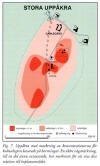|
The site
at Uppåkra, with its sensational finds and unique continuity, more than
1000 years, all through the Iron Age, is situated on a rise in the
landscape, not far from the coast and about 2 km north-west of
Staffanstorp and 5 km south of Lund. It lies within a geographical region
with long traditions seen in the archaeological and historical material.
This region cover most parts of western and southern Scania, with Denmark
located to the west and continental Europe to the south. Several
settlements, grave monuments, graves and finds from the Stone Age and the
Bronze Age show the early establishments in the region. During the Iron
Age, market- and trading places developed and settlements grew, indicating
the economic importance and good location. A large number of churches were
during the early Middle Ages built in the region, most probably as a
result of the positive economic situation.
Within
the municipality of
Staffanstorp,
settlements, grave monuments, graves and finds from the
Stone Age (9000 – 1800 BC), the
Bronze Age
(1800 – 500 BC)
and the
Iron Age (500 BC
–1050 AD) are registered. At Uppåkra today, two mounds are the only
visible remains reminding us of the fantastic site that once was a
regional centre. There have been at least four mounds on the rise.
Regarding their individual dating, they might be dated to the Early Iron
Age, but they could also have been erected during the Bronze Age. The
unique continuity of occupation at the site, has its first traces dated to
Pre-Roman Iron Age (500 BC- the Birth of Christ, also known as the Celtic
Iron Age) and continued throughout the first millennium AD. Uppåkra is the
largest occupation site in southern Sweden with occupation remains found
within an area of approximately 1,1 x 0,6 km (about 40 hectare). Results
from drillings show that occupation layers within four larger areas are
more than one metre thick, and can even have a thickness of more than two
metres. The thick occupation layers could also be indicated by the high
percentage of phosphate being measured in the cultivated lands of Uppåkra
in the 1930’s. Phosphate was then measured in the cultivated lands of
Scania as help to find the most suitable areas to grow sugar beets on.
Uppåkra had the highest percentage and concentration! Thick occupation
layers show that the people have chosen to stay within a specific area for
a very long time, building new
houses
not far from where the old ones were torn down. This, together with the
remains and traces of different kinds of activities, created the
occupation layers that can be found today.
In 1934,
house constructing took place at the site and this revealed finds that led
to the first excavation. The occupation layers had a thickness of more
than two metres, and the site was then estimated to cover an area of about
100 x 110 m. Today, as mentioned before, the site is more likely to cover
an area of approximately 1,1 x 0,6 km.
Uppåkra
was set in focus again in 1996 through a project about the social
structure in southern Sweden during the Iron Age. The use of metal
detectors has been a very useful complement to the excavations. A Danish
group of people with long experience of working with metal detectors have
been of great help. Several surveys have been done, giving sensational
results. Over 20 000 objects have been found in the plough zone! Most of
the objects found by metal detector are dated to the Late Iron Age
(400-1050 AD), because of the limitation to the plough zone. Many finds
are well preserved despite the fact that the land has been cultivated for
a very long time. With the exact location of the finds, it is possible in
a computer to see the spread and eventual concentrations of different
objects over the site. It is also interesting to see the spread of
dateable objects representing different time periods. All these objects
are useful for the understanding of the site, its functions and
activities. Without them, important information would be lost.
Gullåkra bog
is situated 2 km southeast of Uppåkra, just outside Staffanstorp. This bog
has been used for votive offerings for a long period of time. There are
finds dated to the Stone Age, the Bronze Age and the Iron Age. Its
location close to Uppåkra indicates that people from the site probably
used the bog for sacrifices too. Several finds have been made. Finds to be
mentioned: a torc made of bronze and four lanceheads. The torc is dated to
Pre-Roman Iron Age (500 BC - the Birth of Christ, Celtic Iron Age), and
the lanceheads can be dated to around 200 - 500 AD. One of them has been
deliberately bent.
An old
road, with a possible origin in the Iron Age, runs through the site and
parts of it are still used today. The road probably stretched from the
north-west coast of Scania to the southern coast, passing and connecting
important locations along its way.
A runic stone in Hjärup
is the only inscription found close to Uppåkra, showing the contacts and
importance of the area. It was erected around the year 1000 AD. The
inscription gives the information that a man, Navne, had the stone erected
in memory of his brother Toke, who died somewhere west.
|

The Staffanstorp area |

The Uppåkra area |

Uppåkra-occupation layers |

The runic stone in Hjärup |
|